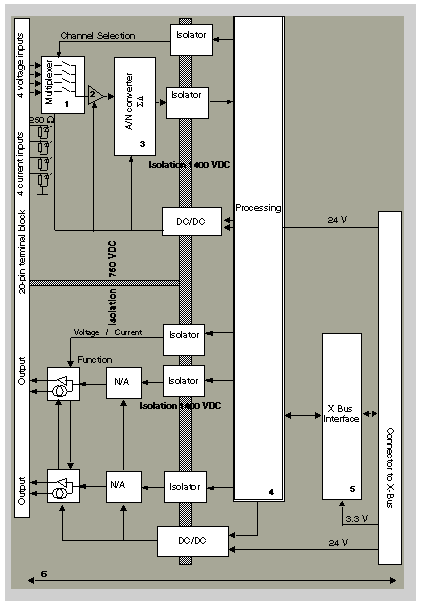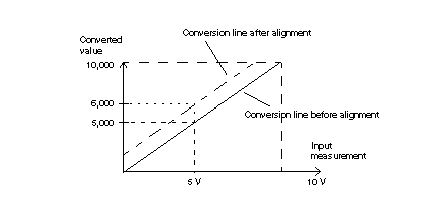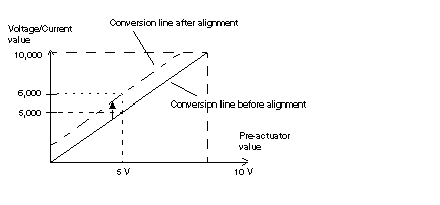|
Functional Description
|
|
|
Original instructions
|

|
Address
|
Process
|
Characteristics
|
|---|---|---|
|
1
|
Adaptation
|
|
|
2
|
Adapting the signal
|
|
|
3
|
Converting
|
|
|
4
|
Transforming application data into data directly usable by the digital/analog converter
|
|
|
5
|
Communicating with the Application
|
|
|
6
|
Module monitoring and sending error notifications back to the application
|
|
|
Module
|
Normal Cycle
|
Fast Cycle
|
|---|---|---|
|
BMX AMM 0600
|
5 ms
|
1 ms + (1 ms x N)
where N: number of channels in use.
|


|
Designation
|
Description
|
|---|---|
|
Nominal range
|
measurement range corresponding to the chosen range
|
|
Upper Tolerance Area
|
varies between the values included between the maximum value for the range (for instance: +10 V for the +/-10 V range) and the upper threshold
|
|
Lower Tolerance Area
|
varies between the values included between the minimum value for the range (for instance: -10 V for the +/-10 V range) and the lower threshold
|
|
Overflow Area
|
area located beyond the upper threshold
|
|
Underflow Area
|
area located below the lower threshold
|
|
Range
|
BMX AMM 0600 Inputs
|
||||||||||
|---|---|---|---|---|---|---|---|---|---|---|---|
|
Underflow Area
|
Lower Tolerance Area
|
Nominal Range
|
Upper Tolerance Area
|
Overflow Area
|
|||||||
|
Unipolar
|
0...10 V
|
-1,250
|
-1,001
|
-1,000
|
-1
|
0
|
10,000
|
10,001
|
11,000
|
11,001
|
11,250
|
|
0...5 V /
0...20 mA
|
-5,000
|
-1,001
|
-1,000
|
-1
|
0
|
10,000
|
10,001
|
11,000
|
11,001
|
15,000
|
|
|
1...5 V /
4...20 mA
|
-4,000
|
-801
|
-800
|
-1
|
0
|
10,000
|
10,001
|
10,800
|
10,801
|
14,000
|
|
|
Bipolar
|
+/- 10 V
|
-11,250
|
-11,001
|
-11,000
|
-10,001
|
-10,000
|
10,000
|
10,001
|
11,000
|
11,001
|
11,250
|
|
User
|
+/- 10 V
|
-32,768
|
|
User-defined
|
User-defined
|
32,767
|
|||||
|
0...10 V
|
-32,768
|
|
User-defined
|
User-defined
|
32,767
|
||||||
|
Type of Range
|
Display
|
|---|---|
|
Unipolar range
0...10 V, 0...5 V, 1...5 V, 0...20mA, 4...20mA
|
from 0 to 10,000 (0 % at +100.00 %)
|
|
Bipolar range
+/- 10 V, +/- 5 mV +/- 20 mA
|
from -10,000 to 10,000 (-100.00 % at +100.00 %)
|

|
Desired Efficiency
|
Required Value
|
Corresponding α
|
Filter Response Time at 63%
|
Cut-off Frequency (in Hz)
|
|---|---|---|---|---|
|
No filtering
|
0
|
0
|
0
|
0
|
|
Low filtering
|
1
2
|
0.750
0.875
|
4 x T
8 x T
|
0.040 / T
0.020 / T
|
|
Medium filtering
|
3
4
|
0.937
0.969
|
16 x T
32 x T
|
0.010 / T
0.005 / T
|
|
High filtering
|
5
6
|
0.984
0.992
|
64 x T
128 x T
|
0.0025 / T
0.0012 / T
|


|
Designation
|
Description
|
|---|---|
|
Nominal range
|
measurement range corresponding to the chosen range
|
|
Overflow Area
|
area located beyond the upper threshold
|
|
Underflow Area
|
area located below the lower threshold
|
|
Range
|
BMX AMM 0600 outputs
|
|||||
|---|---|---|---|---|---|---|
|
Underflow Area
|
Nominal Range
|
Overflow Area
|
||||
|
+/- 10V
|
-11,250
|
-11,001
|
-11,000
|
11,000
|
11,001
|
11,250
|
|
0..20mA
|
-2,000
|
-1,001
|
-1,000
|
11,000
|
11,001
|
12,000
|
|
4..20mA
|
-1,600
|
-801
|
-800
|
10,800
|
10,801
|
11,600
|
|
Error
|
Behavior of Voltage Outputs
|
Behavior of Current Outputs
|
|---|---|---|
|
Task in STOP mode, or program missing
|
Fallback/Maintain (channel by channel)
|
Fallback/Maintain (channel by channel)
|
|
Communication interruption
|
||
|
Configuration Error
|
0 V (all channels)
|
0 mA (all channels)
|
|
Internal Error in Module
|
||
|
Output Value out-of-range (range under/overflow)
|
Value saturated at the defined limit (channel by channel)
|
Saturated value (channel by channel)
|
|
Output short circuit or open circuit
|
Short-circuit: Maintain (channel by channel)
|
Open circuit: Maintain (channel by channel)
|
|
Module Hot swapping (processor in STOP mode)
|
0 V (all channels)
|
0 mA (all channels)
|
|
Reloading Program
|
 WARNING WARNING |
|
UNEXPECTED EQUIPMENT OPERATION
The fallback position should not be used as the sole safety method. If an uncontrolled position can result in a hazard, an independent redundant system must be installed.
Failure to follow these instructions can result in death, serious injury, or equipment damage.
|
